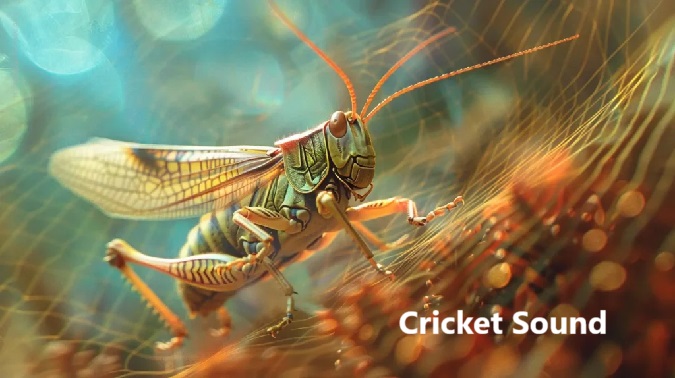Introduction
The gentle sound of crickets chirping is a quintessential part of summer nights. But have you ever wondered why crickets make this sound? Whether you find it soothing, mysterious, or even eerie, the “cricket sound” holds fascinating biological, cultural, and environmental significance.
In this blog post, we’ll explore the science behind cricket sounds, how they produce this melody, their role in ecosystems, and their symbolic meanings across cultures. We’ll also dive into how these insects respond to environmental changes and how their chirps can even help you tell the temperature!
Table of Contents
- What Is the Cricket Sound?
- How Do Crickets Produce Their Chirping?
- The Purpose of Cricket Chirping
- Cricket Sounds and Environmental Indicators
- Cultural Significance of Cricket Sounds
- FAQs About Cricket Sounds
1. What Is the Cricket Sound?
Cricket sound refers to the distinct chirping or trilling noises produced by male crickets, primarily during the evening and nighttime. This rhythmic sound varies in tone, frequency, and pattern depending on the species, environmental conditions, and purpose.
2. How Do Crickets Produce Their Chirping?
Crickets create their iconic sound through a process called stridulation, which involves rubbing specific body parts together.
- Mechanism of Sound Production:
Male crickets rub a serrated edge on one wing (the scraper) against a hard ridge on the other wing (the file). The rapid movement generates vibrations, producing sound waves that resonate.
| Feature | Description |
|---|---|
| Wings | Equipped with specialized ridges and scrapers |
| Stridulation | Mechanism of rubbing wings to create sound |
| Amplification | Wings act as resonators to amplify sound |
- Role of Frequency:
The chirping frequency depends on the cricket’s species and environmental factors like temperature.
3. The Purpose of Cricket Chirping
Cricket chirping is not random; it serves essential purposes:
a) Mating Calls
Male crickets chirp to attract females. The tone, rhythm, and volume indicate their health and genetic fitness.
b) Territorial Warnings
Chirping can signal other males to stay away, asserting territorial dominance.
c) Communication
Different patterns of chirps convey various messages, such as warnings of predators or environmental cues.
| Chirping Type | Purpose |
|---|---|
| Mating Chirps | To attract female partners |
| Aggressive Chirps | To ward off rival males |
| Alarm Chirps | To signal danger or predators |
4. Cricket Sounds and Environmental Indicators
Crickets are often referred to as “nature’s thermometers.” The frequency of their chirping is closely linked to temperature.
a) Calculating Temperature with Cricket Chirps
You can estimate the temperature in Fahrenheit using the following formula:
- Count the number of chirps in 14 seconds.
- Add 40 to this number.
- The result is an approximation of the ambient temperature in Fahrenheit.
For example:
If you count 30 chirps in 14 seconds:
30 + 40 = 70°F
b) Sensitivity to Environmental Changes
Crickets are sensitive to temperature, humidity, and pollution levels. A sudden change in their chirping behavior can indicate shifts in the environment.
| Environmental Factor | Effect on Chirping |
|---|---|
| Temperature | Chirping rate increases with heat |
| Humidity | Impacts sound clarity and intensity |
| Pollution | Reduces population and chirping activity |
5. Cultural Significance of Cricket Sounds
The sound of crickets has transcended its biological purpose, finding a place in folklore, literature, and music across cultures.
a) Symbolism
- Good Luck: In many cultures, cricket sounds are believed to bring good fortune.
- Loneliness: Western literature often associates cricket chirping with solitude.
- Nature’s Harmony: The rhythmic chirping represents tranquility and connection to nature.
b) Crickets in Literature and Art
Crickets often symbolize the passage of time, the onset of night, or introspection.
| Culture | Symbolism of Cricket Sounds |
|---|---|
| Chinese | Symbol of prosperity and life’s vitality |
| Native American | Seen as a guide and a sign of introspection |
| European | Represents stillness and nostalgia |
6. FAQs About Cricket Sounds
Q1: Do all crickets chirp?
A: No, only male crickets chirp, as females lack the necessary wing structures for stridulation.
Q2: Why do crickets chirp louder at night?
A: Crickets are nocturnal, and the reduced background noise at night amplifies their chirping, making it more effective for communication.
Q3: Can cricket sounds be annoying?
A: While many find the sound soothing, excessive chirping near living spaces can be bothersome.
Q4: Are cricket sounds a sign of infestation?
A: A high concentration of chirping near your home may indicate a cricket infestation, requiring pest control measures.
Conclusion
Cricket sounds are more than just a background melody of nature. They serve critical biological roles, offer environmental insights, and hold deep cultural meanings. Understanding the science and significance of these sounds enhances our appreciation for the natural world and its intricate systems.
Whether you hear them as soothing or mysterious, the sound of crickets reminds us of the delicate balance of life and the rhythms of nature.






